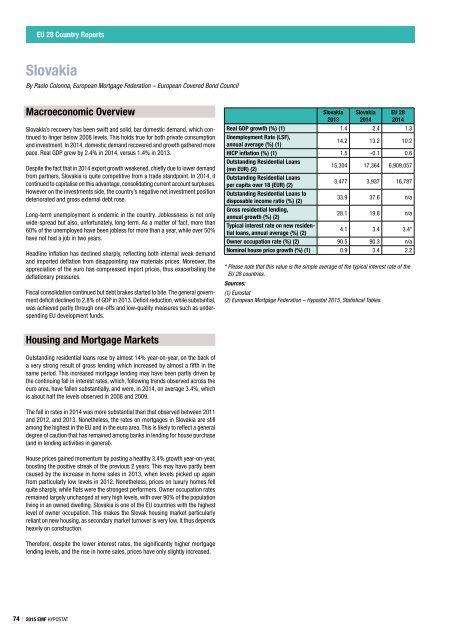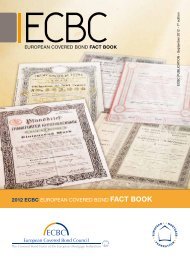Hypostat 2015
On 30 September 2015, the EMF-ECBC published Hypostat 2015 , which is its main statistical report, encompassing data on recent developments in housing and mortgage markets in the EU28 and beyond. Hypostat is the result of a collaborative effort by the European Mortgage Federation’s national delegations and external experts. The publication covers 33 countries – i.e. the EU28 plus Iceland, Norway, Russia, Turkey and the United States.
On 30 September 2015, the EMF-ECBC published Hypostat 2015 , which is its main statistical report, encompassing data on recent developments in housing and mortgage markets in the EU28 and beyond. Hypostat is the result of a collaborative effort by the European Mortgage Federation’s national delegations and external experts.
The publication covers 33 countries – i.e. the EU28 plus Iceland, Norway, Russia, Turkey and the United States.
Create successful ePaper yourself
Turn your PDF publications into a flip-book with our unique Google optimized e-Paper software.
EU 28 Country Reports<br />
Slovakia<br />
By Paolo Colonna, European Mortgage Federation – European Covered Bond Council<br />
Macroeconomic Overview<br />
Slovakia’s recovery has been swift and solid, bar domestic demand, which continued<br />
to linger below 2008 levels. This holds true for both private consumption<br />
and investment. In 2014, domestic demand recovered and growth gathered more<br />
pace. Real GDP grew by 2.4% in 2014, versus 1.4% in 2013.<br />
Despite the fact that in 2014 export growth weakened, chiefly due to lower demand<br />
from partners, Slovakia is quite competitive from a trade standpoint. In 2014, it<br />
continued to capitalise on this advantage, consolidating current account surpluses.<br />
However on the investments side, the country’s negative net investment position<br />
deteriorated and gross external debt rose.<br />
Long-term unemployment is endemic in the country. Joblessness is not only<br />
wide-spread but also, unfortunately, long-term. As a matter of fact, more than<br />
60% of the unemployed have been jobless for more than a year, while over 50%<br />
have not had a job in two years.<br />
Headline inflation has declined sharply, reflecting both internal weak demand<br />
and imported deflation from disappointing raw materials prices. Moreover, the<br />
appreciation of the euro has compressed import prices, thus exacerbating the<br />
deflationary pressures.<br />
Fiscal consolidation continued but debt brakes started to bite. The general government<br />
deficit declined to 2.8% of GDP in 2013. Deficit reduction, while substantial,<br />
was achieved partly through one-offs and low-quality measures such as underspending<br />
EU development funds.<br />
Slovakia<br />
2013<br />
Slovakia<br />
2014<br />
EU 28<br />
2014<br />
Real GDP growth (%) (1) 1.4 2.4 1.3<br />
Unemployment Rate (LSF),<br />
annual average (%) (1)<br />
14.2 13.2 10.2<br />
HICP inflation (%) (1) 1.5 -0.1 0.6<br />
Outstanding Residential Loans<br />
(mn EUR) (2)<br />
15,304 17,364 6,909,057<br />
Outstanding Residential Loans<br />
per capita over 18 (EUR) (2)<br />
3,477 3,937 16,787<br />
Outstanding Residential Loans to<br />
disposable income ratio (%) (2)<br />
33.9 37.6 n/a<br />
Gross residential lending,<br />
annual growth (%) (2)<br />
28.1 19.8 n/a<br />
Typical interest rate on new residential<br />
loans, annual average (%) (2)<br />
4.1 3.4 3.4*<br />
Owner occupation rate (%) (2) 90.5 90.3 n/a<br />
Nominal house price growth (%) (1) 0.9 3.4 2.2<br />
* Please note that this value is the simple average of the typical interest rate of the<br />
EU 28 countries.<br />
Sources:<br />
(1) Eurostat<br />
(2) European Mortgage Federation – <strong>Hypostat</strong> <strong>2015</strong>, Statistical Tables.<br />
Housing and Mortgage Markets<br />
Outstanding residential loans rose by almost 14% year-on-year, on the back of<br />
a very strong result of gross lending which increased by almost a fifth in the<br />
same period. This increased mortgage lending may have been partly driven by<br />
the continuing fall in interest rates, which, following trends observed across the<br />
euro area, have fallen substantially, and were, in 2014, on average 3.4%, which<br />
is about half the levels observed in 2008 and 2009.<br />
The fall in rates in 2014 was more substantial than that observed between 2011<br />
and 2012, and 2013. Nonetheless, the rates on mortgages in Slovakia are still<br />
among the highest in the EU and in the euro area. This is likely to reflect a general<br />
degree of caution that has remained among banks in lending for house purchase<br />
(and in lending activities in general).<br />
House prices gained momentum by posting a healthy 3.4% growth year-on-year,<br />
boosting the positive streak of the previous 2 years. This may have partly been<br />
caused by the increase in home sales in 2013, when levels picked up again<br />
from particularly low levels in 2012. Nonetheless, prices on luxury homes fell<br />
quite sharply, while flats were the strongest performers. Owner occupation rates<br />
remained largely unchanged at very high levels, with over 90% of the population<br />
living in an owned dwelling. Slovakia is one of the EU countries with the highest<br />
level of owner occupation. This makes the Slovak housing market particularly<br />
reliant on new housing, as secondary market turnover is very low. It thus depends<br />
heavily on construction.<br />
Therefore, despite the lower interest rates, the significantly higher mortgage<br />
lending levels, and the rise in home sales, prices have only slightly increased.<br />
74 | <strong>2015</strong> EMF HYPOSTAT



